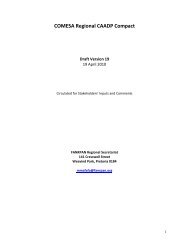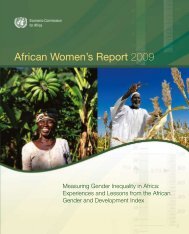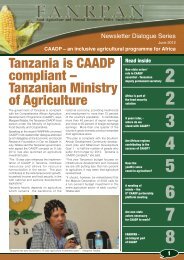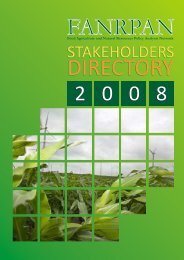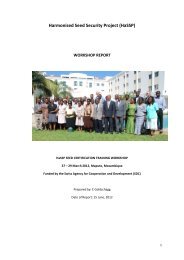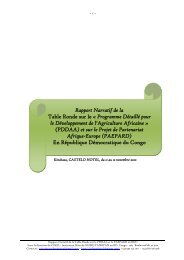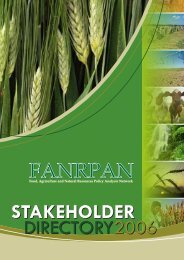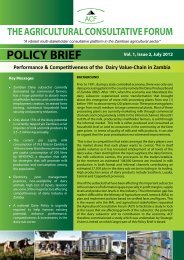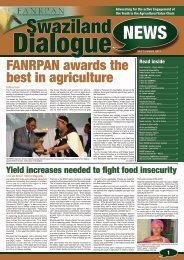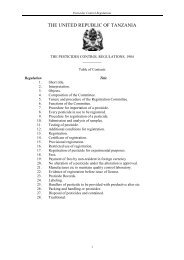Community-driven development decision tools for rural - IFAD
Community-driven development decision tools for rural - IFAD
Community-driven development decision tools for rural - IFAD
- No tags were found...
You also want an ePaper? Increase the reach of your titles
YUMPU automatically turns print PDFs into web optimized ePapers that Google loves.
A note on fiscal decentralization1. Central government budgeting and financial systems are governed by a culture thatemphasizes stability. The systems <strong>for</strong> collecting revenue and releasing funds are gearedtowards controlling expenditures. To this end, public finance is managed by the principle ofthe Unified Consolidated Current Account (UCCA), whereby all fiscal revenue (e.g. taxes,levies, duties) and non-fiscal revenue (e.g. fees, charges <strong>for</strong> services rendered, revenue fromother sources) is deposited in a central account at the treasury (i.e. the government bank) andis released from this account to different government agencies. The balance in the UCCA thusrepresents the current cash flow position of the government. The treasury regulates the releaseof funds in accordance with the availability of funds during the fiscal year.2. Public funds are released in accordance with the budget vote of the National Assembly, whichempowers the government to collect and spend financial resources. Each ministry, orgovernment agency of similar rank, is headed by an officer (normally the Principal Secretary)who is the Chief Accounting Officer (CAO) of the ministry or agency. The treasury issues tothe CAO the Authority to Incur Expenditure (AIE) in accordance with the budget vote,generally on a quarterly basis. The AIE specifies the amounts <strong>for</strong> each item of expenditure inthe approved budget vote. Each CAO then issues subsidiary AIEs (i.e. warrants) to designatedofficials of the agency authorizing them to incur expenditures up to the limit stated in theAIE. The warrant holding officer is authorized to issue payment vouchers up to the limitstated in the warrant <strong>for</strong> each authorized item. These vouchers instruct the treasury to makepayments to suppliers. AIEs and warrants do not include authority to pay governmentsalaries, which are paid directly by the treasury.3. De-concentration introduces some changes in these procedures. One change involvesAppropriations-in-Aid (AIA) which fall into two categories: (i) non-fiscal revenue (e.g. charges<strong>for</strong> services rendered or revenue from the sale of goods, such as vaccines) and the occasionalsale of equipment, and (ii) funds made available by external loans or grants. De-concentratedunits of a central ministry may be allowed to retain AIA. When the non-fiscal revenuecomponent of AIA is not deposited in the UCCA, the treasury tends to release funds to deconcentratedunits on a net basis (i.e. assuming that the cash flow requirement is equivalentto the expected expenditure, less the targeted revenue from AIA sources). Failure to collect thetargeted revenue by a de-concentrated unit generates a cash shortfall at the local level.4. Fiscal decentralization deals with the authority and mechanisms to raise and transfer publicfinancial resources. It is one of the aspects of public administration re<strong>for</strong>m that has beenwidely debated and experimented with in several developing countries during the last decade.Different <strong>for</strong>ms of decentralization imply different <strong>for</strong>ms of authority transfer andinstruments <strong>for</strong> collecting and transferring public funds. Some of these have been used <strong>for</strong> along time, while others were introduced in the 1990s.5. A PCU represents a <strong>for</strong>m of temporary decentralization of some of the functions of thepublic administration in matters related to the implementation of an externally fundedproject. Policy and instruments of fiscal decentralization can be quite relevant whendesigning a PCU’s financial arrangements so that project activities may be sustainable afterproject completion.86



